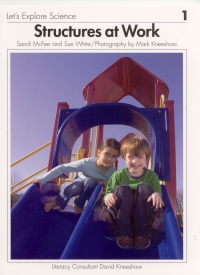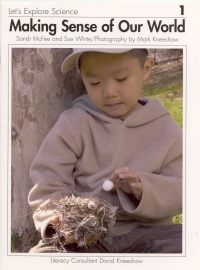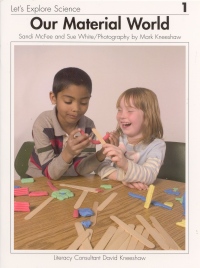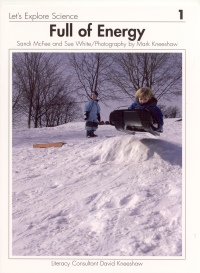| ________________
CM . . .
. Volume XIII Number 11 . . . .January 19, 2007
The "Let's Explore Science 1" series is a set of five small books created as cross-curricular reading material for the language arts series "Let's Explore Language." Authors Sandi McFee and Sue White have developed the Grade 1 science series to encourage reading in science as students actively investigate and develop the skill and knowledge expectations of the Ontario science and technology curriculum. Full of Energy, for example, introduces readers to energy by asking and answering the following questions: What is energy? Where does energy come from? What does energy do? How do we know when to use electricity? How can you save energy? This is followed by a two-page section, "Let's Explore," where readers are invited to "draw a picture of three things that use electricity" and to think about what they would do if the lights and heat went off in their homes. The book ends with a one-page glossary of the science terminology included in the text (e.g. batteries, electricity, energy, gas). McFee and White use this format for all five titles in the series substituting factual statements about materials, structures, the senses, and the seasons in Our Material World, Structures at Work, Making Sense of Our World, and Seasons and the Sun for the questions that provide the context and organization for Full of Energy. Each book is soft covered, stapled through the centre fold, and illustrated with the colour photographs of Mark Kneeshaw. There is also the occasional non-photographic illustration. Seasons and the Sun, for example, includes what appear to be clip art and chalk drawings of Earth and the positions of the Sun relative to Earth to illustrate morning, noon, and evening (day time) and night time. McFee and White have written a 61 page Teacher Guide to accompany and support the use of the "Let's Explore Science 1" series. The Teacher Guide, which is organized by book, addresses separately the content contained in each. These sections begin with a listing of the relevant expectations in the Ontario science and technology curriculum and the page number(s) where each specific expectation is addressed in the book and the teacher guide. This is followed by a list of materials necessary for teaching (including the black line masters, BLMs, that account for the second half of the guide), teaching ideas, language arts connections, and ideas for extended learning, enrichment, and assessment. Using Our Material World as one example, the teacher is referred to a "letter to family" black line master on page 38 that "explains what students will learn over the next few weeks, and gives suggestions for how support may be offered." Twenty-two materials and three BLMs are required for the activities that particular pages in the book were written to supplement. The first activity associated with pages 3 and 4 in Our Material World suggests that teachers "gather objects made of wood, paper, plastic, glass, metal and cloth" and place them "in an accessible location for students to see and touch." When students have had an opportunity to explore the objects, the teacher is to help them recognize that "objects are made from different kinds of materials" and to name the materials used to make each object on display. This is followed by a sorting activity that asks students to match an object with a label of the material it is made from. The "Language Arts Connect" suggested by McFee and White is to construct a classroom word wall using new material words as they occur in student-teacher discussions. Subsequent activities include a school yard search for three natural materials, a drawing of an object each found material could be used to make, a discussion of manufactured materials, paper making, identification of the properties of objects made from particular materials, sorting images of natural and manufactured materials, observing changes to materials, recognizing that an object can be made of more than one material and that a particular object, like a chair, can be made of plastic or wood or metal, reusing materials to make a new object, and sorting objects by material and graphing the results. McFee and White also include a second "Language Arts Connect," an "Extend Learning" idea, and a "Materials Checklist" as a means of assessment. The Teacher Guide is necessary for those who choose to use the series, for it is the Teacher Guide that proposes first-hand experiences that make the information presented in the books meaningful for Grade 1 learners. This is not to suggest that the guide is flawless. Although the activities change from book to book, there is sameness to the tasks students are to perform, the language arts connections, and the methods of assessment. The books in the series include information that McFee and White should consider revising. In Structures at Work, readers are given the impression that only objects made by humans and some animals (spiders, wasps, and birds) are structures. At the very least, children should be helped to know that seeds, leaves, flowers, skeletons, bones, teeth, claws, feathers, snow flakes, and the like are structures. In Our Material World, page 19, the authors write that "other metals are made by humans." This statement is illustrated with a photograph of a hand holding nails and a photograph of fourteen Canadian coins on a sheet of aluminum foil. Are Grade 1 students to believe that metals are made by humans, or that metals extracted from the Earth are used by humans to make objects like nails and coins? On page 7 of Making Sense of Our World, McFee and White write, "Plants need food, air, and water to live. They need light too." The caption under a photograph of a boy watering a plant states: "Plants get food from soil." This is a statement that scientists and science educators would label a misconception. Plants are primary producers. They make their own food (glucose) from carbon dioxide in the air, water in the substrate, and energy from the Sun's light. In Seasons and the Sun, the drawings of day and night and the position of the Sun relative to Earth are confusing and unlikely to help children in their understanding of these concepts. Where on Earth, for example, is the Sun "right overhead" in the afternoon (p. 7)? Do we "get day and night" because "earth slowly turns around the sun" (p. 9)? Why is the position of the Sun changed from page 10 to page 11? It would seem to make more sense to leave the Sun in the position it is given on page 10 and show the rotation of Earth on its axis for day and night. In Full of Energy, it will likely be more meaningful for children if it is clear that energy can come from moving water (p. 10), that fuel or gasoline are forms of energy as opposed to "gas," a scientific term that refers to a state of matter (p. 11), and that energy can be conserved (not used) rather than saved (pp. 26-29). The first two changes will certainly help children to successfully complete the BLM, "Kinds of Energy," on page 35 in the Teacher Guide. It would also help if the authors replaced the drawing of the calculator with a solar powered calculator, if moving water was shown doing work rather than children bathing in a bathtub, and if an electrical cord and plug were attached to the CD player. Not Recommended. Barbara McMillan is a professor of early and middle years science education in the Faculty of Education, the University of Manitoba.
To comment
on this title or this review, send mail to cm@umanitoba.ca.
Copyright © the Manitoba Library Association. Reproduction for personal
use is permitted only if this copyright notice is maintained. Any
other reproduction is prohibited without permission.
NEXT REVIEW |
TABLE OF CONTENTS FOR THIS ISSUE
- January 19, 2007.
AUTHORS |
TITLES |
MEDIA REVIEWS |
PROFILES |
BACK ISSUES |
SEARCH |
CMARCHIVE |
HOME |




